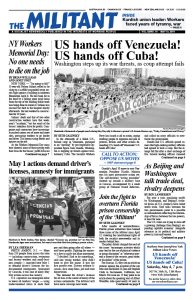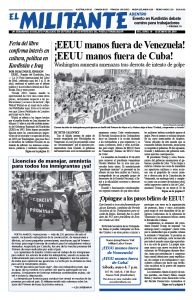NEW YORK — “I’m going to fall!” 51-year-old Nelson Salinas yelled as he clung to a scaffold suspended seven stories high against a building in midtown Manhattan April 8. He had been hit in the head by a falling stone pried loose from the top of the building while work was being done to restore it. Salinas was rescued but died in the hospital shortly afterwards. He had worked in construction for 20 years.
Salinas’ death and that of two other construction workers here that week, aren’t “accidents,” but the result of the bosses’ relentless drive for profits. Companies and contractors have increasingly pushed unions out of more and more sites, pressuring workers to go harder and faster. This means rising deaths and injuries on the job.
As the Workers Memorial Day mass here showed, most of those paying with their lives for the bosses’ profit drive are workers employed at nonunion sites.
Union membership in New York’s construction industry has dropped from 90 percent in the 1970s to less than 31 percent today. Union officials say it’s hard to organize because many of these workers don’t have legal papers, but they don’t do anything to fight for amnesty and legalization as part of organizing them.
Vlad Restoration, the contractor Salinas was working for, was sued last year by six demolition workers for $290,000 over unpaid overtime, a suit the bosses finally settled for less than half that amount. The building where Salinas worked was by the site of a crane collapse in 2008 that killed six workers and a pedestrian.
Two days after Salinas’ death, Erik Mendoza, 23, fell 13 stories to his death while working on the roof of a luxury building in Brooklyn Heights. He and another worker had been placing bricks underneath the building’s water tower. It was Mendoza’s first week on that job.
On April 13, 34-year-old Gregory Echevarria, a crane rigger, was crushed to death when part of a 16-wheeler crane he was helping to assemble came crashing down on him at a SoHo construction site near the Holland Tunnel.
The company he worked for, Cranes Express Inc., brags on its website it is “the largest non-union crane company in NYC.” Since July seven complaints have been filed against the company, including over unsafe conditions, according to Department of Buildings records. In 2016 two construction workers were killed when a beam being hoisted into place by a Cranes Express-owned crane fell four stories at a construction site in Queens.
Construction most dangerous job
Construction, followed by transportation and agriculture, are the most dangerous jobs across the country. Nine hundred seventy-one construction workers were killed in 2017, reported the AFL-CIO in “Death on the Job: The Toll of Neglect” published this April.
Overall, 5,147 workers lost their lives from traumatic injuries on the job in 2017, the Bureau of Labor Statistics reported.
That means each and every day an average of 14 workers in the U.S. die from injuries on the job. And an estimated 95,000 more die each year from diseases caused by conditions where they work. Put together, about 275 workers die each day due to job injuries and work-related illnesses, the AFL-CIO reported.
With “widespread under-reporting of workplace injuries” by bosses, “the true toll is estimated,” the report says, to be “7.0 million to 10.5 million injuries and illnesses a year.”
For decades, union officials have told workers they can bank on Democratic Party candidates, or occasionally Republicans, to defend the unions, instead of organizing and leading workers in a sustained fight against the attacks of the bosses and the government.
Today, union membership in private industry — where the large majority of injuries and deaths occur — has declined to 6.4 percent of the workforce. The challenge facing working people is to build and transform the unions with the power to ensure safety is enforced on the job.
This was won and implemented by the United Mine Workers union several decades ago. In the late 1960s and ’70s miners led a revolution in their union that put the fight for safety and against deadly black lung disease at the forefront. In a series of popular strikes and social battles they forced the coal bosses to accept union safety committees in the mines with the power to shut production — power they used — to enforce safety.
Then workers need to expand workers control over all aspects of production, so the eyes of the workers penetrate into all the open and hidden workings of the capitalist economy.
Winning workers to union
There are thousands of construction workers — union and nonunion — working across the street from each other and often on the same worksites in this city. Seth Galinsky, Socialist Workers Party candidate for New York City public advocate, and Janet Post visited sites at Penn Station and the massive Hudson Yards construction project April 17 to discuss the on-the-job safety crisis and the need for workers to be organized in unions.
“Without a union, there is pressure to work faster and then there’s more accidents,” one 20-year worker from Ecuador, who is a member of Carpenters union Local 1556, told Galinsky. Most of the workers at this construction site are nonunion, he said.
“No worker should die on the job because of unsafe conditions. That’s why we need to reach out and organize those workers into the union,” Galinsky said.
Another Latino worker heading to the same worksite told Galinsky, “We would like to be in a union, but no one has approached us.”
Across the street, James Hayes, a shop steward from Cement and Concrete Laborers Local 20, was laying a foundation at Hudson Yards. He agreed the unions haven’t done enough to try and organize.
“But we know that some of those workers,” he said, pointing to the nonunion job site across the street, “have lost their jobs just trying to talk to us.”
“If the union went to those workers and said we don’t care where you were born, we’re going to fight for amnesty so that you can’t be deported and we can fight together to stand up to the bosses,” Galinsky said, “and organized a real fight, including shutting down any site that’s unsafe, workers would flock to the union.”

